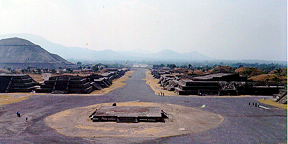|

An exploration of how and why places become invested with SACREDNESS and how the SACRED is embodied or made manifest through ART and ARCHITECTURE
TEOTIHUACÁN, MEXICO
In Nahuatl, Teotihuacán means The City of the Gods, or Where Men Become Gods. The plazas, avenues, and great pyramids of the city of Teotihuacán were laid out as a symbolic sacred landscape of artificial foothills and mountains (cf. Mountains and the Sacred). The complex of approximately 600 pyramids of various sizes is dominated by the great Pyramid of the Sun which, it was discovered in 1971, was built over a natural cave with four chambers (cf. Sacred Caves). Mesoamerican belief saw caves as gateways to the spiritual world (called Xibalba by the Maya). The cave contained remains of offerings and may have been a focus for shamanistic rituals from a much earlier period. There can be no doubt that the Pyramid of the Sun was deliberately built over the sacred cave.
Both the idea of the cave and the artificial mountain constructed over it (or containing it) is also seen among the Ancient Egyptians in the pyramids at Giza.
Bibliography:
|
|






